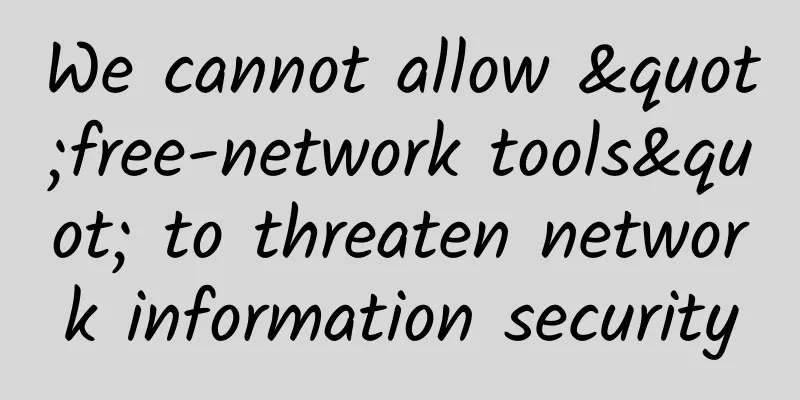Computer Network Architecture

|
The formation of computer network architecture (understanding only) Computer network is a very complex system. This article only introduces it from the architectural level. Please do not delve into the many concepts in it. It is enough to know that computer network is layered. Two computer systems that communicate with each other must work in a highly coordinated manner, and this "coordination" is quite complicated. "Layering" can transform a large and complex problem into several smaller local problems, and these smaller local problems are easier to study and deal with. In 1974, IBM of the United States announced the System Network Architecture (SNA). This famous network standard was developed according to the layered approach. Soon after, other companies also launched their own architectures with different names. Due to the different network architectures, it was difficult for devices from different companies to connect to each other. In order to interconnect computer networks with different architectures, the International Organization for Standardization (ISO) established a special agency in 1977 to study the problem and proposed a standard framework that attempts to interconnect various computers worldwide, namely the famous Open Systems Interconnection Reference Model (OSI/RM), or OSI for short. This means that as long as the OSI standard is followed, a system can communicate with any other system located anywhere in the world that also follows the same standard. OSI only achieved some theoretical research results, but failed in marketization. The reasons include:
The legal international standard OSI has not been recognized by the market. The non-international standard TCP/IP has been the most widely used. TCP/IP is often called the de facto international standard. Protocols and LayersData exchange in computer networks must comply with pre-agreed rules that clearly define the format of the data being exchanged and related synchronization issues. Network protocol, referred to as protocol, is a set of rules, standards or agreements established for data exchange in a network. Network protocol is an indispensable part of computer networks. The three components of network protocols are: 1. Syntax: The structure or format of data and control information. 2. Semantics: what control information needs to be sent, what actions need to be completed, and what responses need to be made. 3. Synchronization: Detailed description of the order in which events are realized. The development experience of ARPANET shows that for very complex computer network protocols, their structure should be hierarchical. The architecture of a computer network is a collection of layers and protocols of a computer network. The architecture is a precise definition of the functions that this computer network and its components should perform. Implementation is the question of what kind of hardware or software is used to perform these functions under the premise of following this architecture. The architecture is abstract, while the implementation is concrete, which is the actual computer hardware and software in operation. As shown in the figure above, (a) represents the seven-layer protocol architecture of OSI, which has clear concepts and relatively complete theories, but is complex and impractical. (b) is the commercially successful four-layer architecture of TCP/IP: application layer, transport layer, internet layer, and network interface layer. However, the bottom network interface layer does not have specific content. (c) is a system architecture that combines the advantages of OSI and TCP/IP and adopts only five-layer protocols. Understanding of OSI's seven-layer protocol architectureApplication layer: Applications that can generate traffic and interact with users, such as WeChat, QQ, Weibo, Tik Tok, etc. Stand-alone applications such as Notepad do not belong to the application layer. Presentation layer: Encryption and compression are performed. This layer requires consideration by developers. Session layer: Sessions established between the server and the client, connecting to the remote desktop, checking for Trojans, telnet -nb Transport layer: reliable transmission, unreliable transmission, flow control Network layer: IP addressing, selecting the best path Data link layer: input how to encapsulate and add physical address. Physical layer: voltage, interface standards, etc. Five-layer protocol architectureThe physical layer mainly includes: the underlying transmission medium, electromagnetic energy and its use, the representation of information in the signal, electrical characteristics such as radio frequency and voltage, and associated hardware. Data link layer: Communication between computers and network hardware, mechanism for accessing shared media, hardware (MAC) addressing, packet (frame) format, data packet (frame) type and demultiplexing, error detection and correction technology. Network layer: realizes communication between two computers through the Internet, datagram format, IP address addressing and allocation, forwarding and routing selection, etc. Transport layer: reliable transmission, unreliable transmission, congestion control (flow control). Application layer: Applications that can generate traffic and interact with users. TCP/IP ArchitectureThe TCP/IP architecture consists of four layers: application layer, transport layer, internet layer, and network structure layer. 1. Application layer: provides interfaces for user applications so that users can access the network. HTTP Hypertext Transfer Protocol (web browsing service), FTP File Transfer Protocol (provides file upload and file download services, which are slow but reliable), SMTP Simple Mail Transfer Protocol (mail sending and forwarding), Talnet remote login function (configure switches and routers), DNS Domain Name System, resolves domain names into IP addresses (converts Baidu's domain name into the server's IP address). 2. Transport layer: provides end-to-end (Port to Port) communication (the connection between software on two computers) and regulates the flow of information. Connection-oriented reliable transmission protocol TCP, and non-connection-oriented user datagram protocol UDP. 3. Internet layer: IP data packet encapsulation and path selection. Main protocols: IP (data packet encapsulation, defining IP addresses), ICMP (error diagnosis, such as using the ping command to test network connectivity), ARP protocol (resolving IP addresses to MAC addresses) and RARP (converting MAC addresses to IP addresses) 4. Network interface layer: The network interface layer is the interface between TCP/IP and various LANs or WANs. Its main function is to unpack IP data packets. TCP/IP architecture, main protocols at each layer: The communication process between two hosts The application process data of host 1 is first transmitted to the application layer, and then added with the application layer header to become the application layer PDU (Protocol Data Unit, Protocol Data Unit, the OSI reference model calls the data unit transmitted between peer layers the protocol data unit PDU of this layer): The application layer PDU is then transmitted to the transport layer, and the transport layer header is added to form a transport layer message: The transport layer message is then transmitted to the network layer, with the network layer header added to become an IP datagram (or packet): The IP datagram is then transmitted to the data link layer, with the link layer header and trailer added to become a data link layer frame: The data link layer frames are then passed to the physical layer, which transmits the bit stream to the physical media: Electrical signals (or optical signals) propagate in physical media (optical fiber, network cable, router, etc.) from the physical layer of the sender to the physical layer of the receiver: The physical layer of host 2 receives the bit stream and hands it over to the data link layer: After the data link layer strips off the frame header and frame tail, it hands the data portion of the frame to the network layer: After the network layer strips off the packet header, it hands the data portion of the packet to the transport layer: After the transport layer strips off the message header, it hands the data portion of the message to the application layer: After the application layer strips off the application layer PDU header, it hands the application data to the application process: Finally, host 2 can process the received application data! The OSI reference model calls the data unit transmitted between peer layers the protocol data unit (PDU) of that layer. This term has now been adopted by many non-OSI standards. Any two identical layers pass data (i.e. data units plus control information) directly to each other through horizontal dotted lines. This is the so-called communication between "peer layers". The protocols of each layer are actually the various regulations for transmitting data between each peer layer. Entities, protocols, services, and service access points An entity is any hardware or software process that can send or receive information. A protocol is a set of rules that govern how two peer entities communicate. Service: that is, upper and lower layers. The lower layer provides services to the upper layer, and the upper layer needs to use the services provided by the lower layer to implement the functions of this layer. Service Access Point SAP (Service Access Point): The place where information is exchanged between two adjacent layers of entities. This article is reprinted from the WeChat public account "Jingyu", which can be followed through the following QR code. To reprint this article, please contact Jingyu public account. |
>>: Research shows that global 5G network infrastructure revenue will grow 39% in 2021
Recommend
Can 5G RedCap technology help operators regain confidence?
As my country has built the world's largest 5...
Mainstream IoT wireless technologies are here!
This article covers: Bluetooth, WiFi, BLE, Zigbee...
How fast is Starlink's internet speed? Foreign netizens tested it
Starlink, the satellite internet service provider...
Work together to build a secure network and digital ecosystem
Today, digital transformation led by emerging tec...
The three major telecom operators are accelerating the construction of 5G networks and data centers
Seizing the opportunity of the country's &quo...
The essence of 5G is speed upgrade! Packages will become cheaper and cheaper
[[356187]] About two years ago, when 5G had just ...
I have no resistance to these 6 excellent computer software
[[389531]] Excellent computer software can greatl...
On the "Kung Fu" of IT Operation and Maintenance
One day, Master Ma was walking on the street and ...
What is 6G? It may appear in 2030, crushing 5G without any pressure
5G has already been deployed, so what about 6G? W...
10gbiz New Year Promotion: Hong Kong/Los Angeles CN2 GIA line VPS 40% off $2.75/month, Bare Metal Server 58% off
10g.biz has launched its 2022 New Year event. In ...
Perhaps it is easier to understand HTTPS this way
We won’t talk about HTTP and HTTPS first. Let’s s...
[11.11] ZJI: Hong Kong Kwai Bay Server 50% off 500 yuan/month-2*E5-2630L/32G memory/1TB SSD/20M bandwidth
During the Double 11 period this year, ZJI launch...
Jingwen Internet's year-end special offer: 30% off on all VPS + free memory, 200 yuan off for independent servers, 300 yuan for 1,000 yuan recharge
It has been exactly half a year since I last shar...
5G, why not completely jointly build and share wireless access networks?
The key to 5G is to provide diversified services ...
Things about WKWebView on iOS
[[413463]] Background Students who are familiar w...









